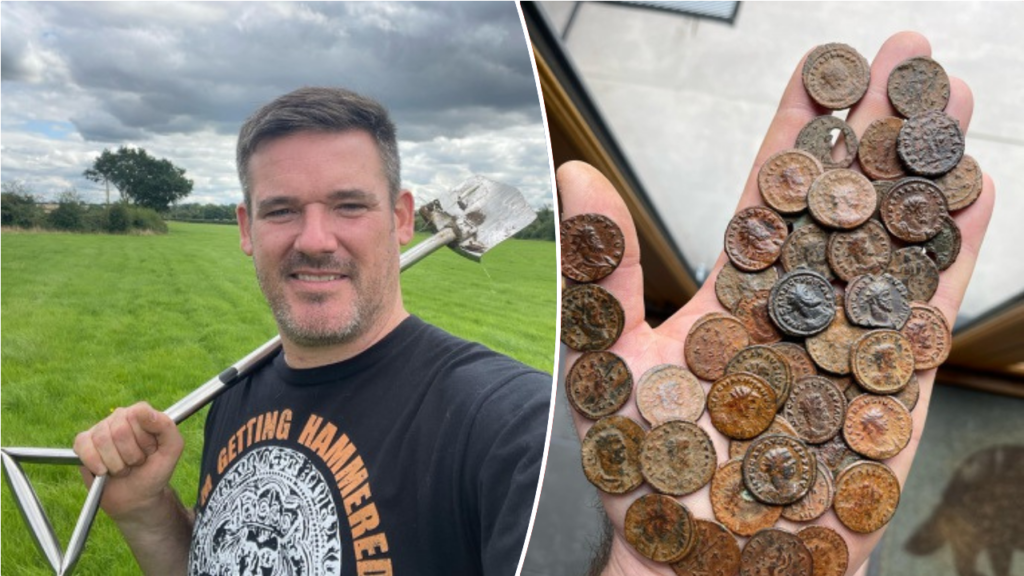On a seemingly ordinary summer’s day, David Dunn, a plumber from Sapcote in Leicestershire, United Kingdom, unearthed a treasure that would thrill any history enthusiast. While wandering through a pasture near his home on July 19, 2023, Dunn stumbled upon a hidden hoard of ancient Roman coins, a discovery he would soon share with the world. This unexpected adventure illustrates the serendipitous outcomes that can arise from curiosity and a passion for metal detecting.
The finding consisted of 50 Roman coins, specifically antoninianus, which were minted during a fascinating period of Roman history. The media outlet Noonans Mayfair, an auction house based in London, made this revelation public through a press release dated February 6, 2024. Dunn took up metal detecting only in 2023, seeking a hobby that allowed him to unwind outdoors after long working hours. This journey into hobbyism led him to his astonishing discovery, bringing history alive in the most unexpected of ways.
Equipped with a Deus 2 metal detector, Dunn embarked on his quest in the pasture — land that he had explored numerous times before. Following a few hours of searching, he picked up a signal that registered 84 on his device while utilizing the Relic Program. This moment, fueled by instinct and intrigue, became pivotal in his treasure hunt. He unearthed a Roman coin, followed by another, all from the same spot, igniting a spark of excitement that compelled him to dig deeper.
Dunn quickly notified the farmer who owned the land, showcasing his integrity and respect for such invaluable finds. As he delved deeper—approximately two feet into the soil—the hoard gradually revealed itself across an area of four square meters. “Who knows what would have happened if we continued digging further!” Dunn recalled, hinting at the untapped potential of the land beneath them.
The coins date back to an impressive era, with the oldest among them being minted under the rule of Carausius, the Roman emperor from 286 to 293 AD, who came to power following the Carausian Revolt. Coins from the reigns of other notable emperors such as Allectus, Diocletian, and Maximian were also present, with the most recent among them tracing back to the fourth century AD.
Leicester, the county seat of Leicestershire, was a significant town during Roman Britain, originally known as Ratae Corieltauvorum. Dunn acknowledged the historical richness of the region, revealing that a neighboring farm housed a Roman villa, highlighting that Roman artifacts are not unusual findings in this area. Dunn exclaimed that many of the coins remained in excellent condition, some displaying intricate portraits—an extraordinary outcome from what can be considered a once-in-a-lifetime archaeological find.
The auction of these historical coins is set for February 18, 2024, with expectations that they could sell for upwards of $1,800. However, Dunn maintains that his primary focus is not financial. “I’m not sure of what to spend it on,” he admitted, emphasizing his genuine passion for unearthing historical treasures and the enjoyment that comes from discovering history itself. He expressed a desire to support the farmer who had faced difficulties in recent years due to the COVID-19 pandemic by sharing a portion of the proceeds with him.
Aside from the personal significance of Dunn’s find, his discovery contributes enormously to the academic sphere, particularly the study of Ancient Roman coins. Alice Cullen, a coin expert from Noonans, remarked that one of the designs from the reign of Carausius represents a new variety that has not been previously recorded. The first coin from this hoard will enter a new volume about Roman coins, emphasizing the historical importance of Dunn’s discovery. This particular coin features a bust of Diocletian on one side and a depiction of a standing woman on the reverse, showcasing the artistry and craftsmanship of that era.
In short, David Dunn’s unexpected find serves as a poignant reminder of the treasures that lie beneath the surface, waiting for someone with the spirit of exploration to unveil them. This story of discovery also encapsulates the joy of engaging with history, an inspiration for both amateur and experienced archaeologists alike.











